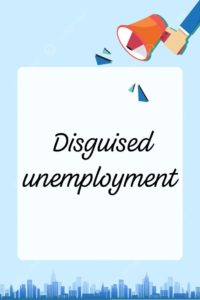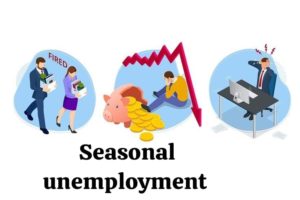What is Unemployment?
Unemployment refers to a situation in which individuals who are willing and able to work are unable to find suitable employment opportunities. It is a measure of the proportion of the labor force that is actively seeking employment but remains unemployed.
Table of Contents
Unemployment can result from various factors, including economic downturns, technological advancements, changes in consumer demand, and structural shifts in industries. It is often associated with negative consequences such as financial hardship, reduced consumer spending, social unrest, and a decline in overall economic growth.
Unemployment is typically measured using indicators such as the unemployment rate, which reflects the percentage of the labor force that is unemployed at a given time. Policymakers, economists, and governments closely monitor unemployment trends and implement measures such as job creation programs, training initiatives, and labor market reforms to reduce unemployment levels and promote economic stability and growth.
Main Points:
- Unemployment occurs when individuals looking for jobs are unable to find employment opportunities.
- While very low unemployment rates may suggest a booming economy, excessively high rates of unemployment signal an economic crisis.
- Various forms of unemployment exist, including institutional, structural, cyclical, and frictional, as well as phenomena like seasonal and disguised unemployment.
- Government agencies employ various techniques to collect and disseminate information on unemployment.
- Many governments offer financial assistance to unemployed individuals through unemployment insurance, provided they meet certain eligibility requirements.
Knowing about Unemployment
Unemployment, a critical economic and social phenomenon, represents the condition where individuals who are willing and able to work cannot secure suitable employment. It serves as a barometer of economic health and social well-being within societies.
Unemployment arises from a myriad of factors, including economic recessions, technological advancements, shifts in consumer demand, and structural changes in industries. It manifests in various forms such as frictional, cyclical, structural, and seasonal unemployment, each with distinct characteristics and implications.
The consequences of unemployment are far-reaching, encompassing financial strain on individuals and families, decreased consumer spending, increased government welfare expenditure, and adverse effects on mental and physical health.
Economists and policymakers employ metrics like the unemployment rate to gauge labor market dynamics, providing insights into the health of economies and guiding policy responses.
Effectively addressing unemployment is essential for fostering economic growth, reducing inequality, and fostering social cohesion in societies worldwide.
Different types of employment
There exists a distinct definition for unemployment, however, economists also utilize alternative classifications. The two main categories are voluntary unemployment and involuntary unemployment. Voluntary unemployment occurs when an individual chooses to leave their job in pursuit of new employment opportunities. On the other hand, involuntary unemployment happens when someone is terminated or laid off and must now seek new job opportunities.
Unemployment types
There are four types of voluntary and involuntary unemployment.
- Frictional Unemployment: This type of unemployment occurs when individuals are temporarily between jobs or are transitioning from one job to another. It is considered voluntary to some extent because individuals may be voluntarily searching for better opportunities or waiting to find a job that matches their skills and preferences. Frictional unemployment is often viewed as a natural and inevitable part of a dynamic labor market where job turnover and mobility are common.
- Structural Unemployment: Structural unemployment arises from a mismatch between the skills and qualifications of workers and the available job opportunities in the labor market. This type of unemployment can be involuntary, as it results from long-term changes in the economy, technological advancements, shifts in consumer preferences, or changes in the structure of industries. Workers may find themselves unemployed because their skills are no longer in demand or because they lack the necessary skills for available positions. Addressing structural unemployment often requires efforts to retrain workers, enhance education and skills training programs, and adapt to changing economic conditions.
- Cyclical Unemployment: Cyclical unemployment is involuntary and occurs as a result of fluctuations in the business cycle. During economic downturns or recessions, businesses may reduce production and lay off workers due to decreased demand for goods and services. Unemployment rises because fewer job opportunities are available. Conversely, during periods of economic expansion, cyclical unemployment tends to decrease as businesses expand and hire more workers to meet increased demand.
- Seasonal Unemployment: Seasonal unemployment occurs due to predictable fluctuations in labor demand that are tied to seasonal variations in industries such as agriculture, tourism, construction, and retail. Workers in seasonal industries may experience unemployment during off-peak seasons when demand for labor decreases. While seasonal unemployment can be involuntary, it is often expected and temporary, as demand for labor typically increases again during peak seasons.
Understanding the different types of unemployment is essential for policymakers, economists, and businesses to develop targeted interventions and policies aimed at reducing unemployment rates, fostering job creation, and promoting economic stability.
What is disguised unemployment?

Disguised unemployment refers to a situation where individuals appear to be employed and part of the workforce, but their contribution to productive activities is minimal or redundant. In other words, it occurs when there are more workers engaged in a particular activity or sector than necessary for optimal productivity.
Key characteristics of disguised unemployment include:
- Underutilization of Labor: In disguised unemployment, there is an excess supply of labor relative to the actual requirements of the task or activity. This means that removing some workers from the activity would not significantly impact overall productivity or output.
- Low Productivity: Workers in disguised unemployment may be engaged in tasks that do not add substantial value to the production process or may perform redundant functions that could be eliminated without affecting output levels.
- Limited Opportunities: Disguised unemployment often occurs in sectors where there are limited alternative employment opportunities available, leading to an overabundance of labor in specific activities or industries.
- Inefficiency in Resource Allocation: Disguised unemployment can result in inefficient allocation of resources, as labor that could be more productive in other sectors remains underutilized in unproductive activities.
Disguised unemployment is commonly associated with certain sectors such as agriculture, where traditional farming methods may require more labor than necessary due to technological advancements or changes in agricultural practices. It can also occur in other sectors of the economy where there is limited mobility of labor or where employment opportunities are constrained.
What is seasonal employment?

Seasonal employment refers to employment that is tied to specific times of the year or seasons and is characterized by fluctuations in demand for labor based on seasonal variations in industries or activities. In seasonal employment, workers are hired to meet temporary increases in demand during certain periods, and the employment may be terminated or reduced when the season ends or demand decreases.
Key features of seasonal employment include:
- Cyclical Nature: Seasonal employment follows predictable patterns or cycles based on factors such as weather conditions, holidays, tourism seasons, agricultural harvests, and retail sales peaks.
- Temporary Nature: Seasonal jobs are temporary in nature and typically last for a limited duration corresponding to the specific season or peak period of demand.
- Industry Dependence: Seasonal employment is prevalent in industries such as tourism, hospitality, agriculture, retail, construction, landscaping, and outdoor recreation, where demand fluctuates with seasonal trends.
- Variety of Jobs: Seasonal employment encompasses a wide range of job roles and responsibilities, including lifeguards at beaches, retail sales associates during holiday shopping seasons, ski instructors at ski resorts, agricultural workers during planting and harvesting seasons, and tour guides during peak tourist seasons.
- Flexibility and Opportunities: Seasonal employment offers flexibility for workers who may be students, retirees, or individuals seeking temporary work opportunities. It provides a source of income during specific periods and may also offer opportunities for gaining experience and skills in various industries.
- Challenges: While seasonal employment can provide valuable income and experience, it also poses challenges such as uncertainty about job availability, fluctuations in income, lack of job security, and limited access to benefits such as healthcare and retirement plans.
Hence, seasonal employment plays a significant role in meeting temporary labor demands during specific periods, supporting economic activities in seasonal industries, and providing employment opportunities for individuals seeking short-term work arrangements.
Key Differences
Here are the key differences between disguised unemployment and seasonal unemployment:
- Nature:
- Disguised Unemployment: Disguised unemployment occurs when individuals appear to be employed but their contribution to productive activities is minimal or redundant. It involves the underutilization of labor where removing some workers would not significantly affect overall productivity.
- Seasonal Unemployment: Seasonal unemployment arises due to predictable fluctuations in labor demand that occur during specific times of the year. Workers experience joblessness during off-peak seasons when demand for labor decreases in seasonal industries.
- Timing and Predictability:
- Disguised Unemployment: Disguised unemployment is not bound by specific times of the year; rather, it can persist throughout the year. It is not inherently predictable and may be present regardless of seasonal variations.
- Seasonal Unemployment: Seasonal unemployment occurs during off-peak seasons when demand for labor decreases due to predictable seasonal fluctuations. It follows a cyclical pattern and tends to recur at certain times of the year.
- Cause and Context:
- Disguised Unemployment: Disguised unemployment often stems from inefficiencies in labor allocation, lack of alternative employment opportunities, or outdated practices in certain sectors, such as agriculture.
- Seasonal Unemployment: Seasonal unemployment primarily results from the nature of industries where demand for labor is tied to seasonal variations, such as tourism, agriculture, construction, and retail.
- Duration and Persistence:
- Disguised Unemployment: Disguised unemployment can persist over the long term, especially in sectors where structural inefficiencies are prevalent. It may not necessarily follow a seasonal pattern and can exist irrespective of economic cycles.
- Seasonal Unemployment: Seasonal unemployment tends to be temporary and short-term, recurring during specific times of the year. It typically resolves as demand for labor increases during peak seasons.
These differences help in understanding the distinct characteristics and implications of disguised and seasonal unemployment, aiding policymakers, economists, and businesses in developing appropriate strategies to address each type of unemployment effectively.
Conclusion

Unemployment is a danger to the economy and the government ought to utilize different ways of adapting up to the rising pace of joblessness to keep a solid economy. Both occasional as well as camouflaged joblessness are a significant issue in countries with high populace like India.
